ASRock Rack TRX40D8-2N2T Performance
For this exercise, we are using our legacy Linux-Bench scripts which help us see cross-platform “least common denominator” results we have been using for years as well as several results from our updated Linux-Bench2 scripts. At this point, our benchmarking sessions take days to run and we are generating well over a thousand data points. We are also running workloads for software companies that want to see how their software works on the latest hardware. As a result, this is a small sample of the data we are collecting and can share publicly. Our position is always that we are happy to provide some free data but we also have services to let companies run their own workloads in our lab, such as with our DemoEval service. What we do provide is an extremely controlled environment where we know every step is exactly the same and each run is done in a real-world data center, not a test bench.
We are going to show off a few results, and highlight a number of interesting data points in this article. You can always reference full reviews of each CPU to get more understanding on how they perform.
Python Linux 4.4.2 Kernel Compile Benchmark
This is one of the most requested benchmarks for STH over the past few years. The task was simple, we have a standard configuration file, the Linux 4.4.2 kernel from kernel.org, and make the standard auto-generated configuration utilizing every thread in the system. We are expressing results in terms of compiles per hour to make the results easier to read:
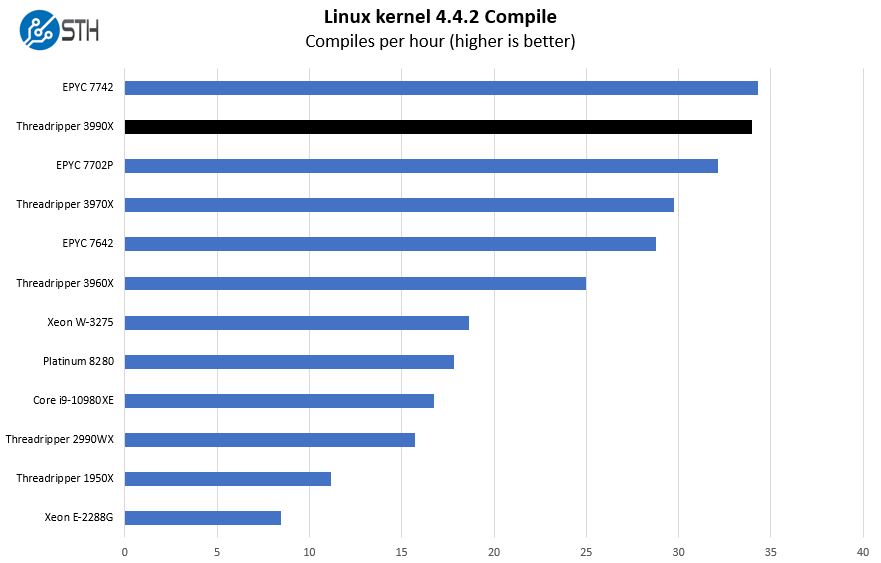
We are going to highlight the AMD Ryzen Threadripper 3990X performance in these charts. Those accustomed to our platform reviews will know that for more mainstream servers we only compare CPUs in the socket(s) found in the system we are reviewing. Here, since that population is effectively three SKUs, we wanted to go broader and show performance versus Xeon and EPYC to give some relative sense of performance.
c-ray 1.1 Performance
We have been using c-ray for our performance testing for years now. It is a ray tracing benchmark that is extremely popular to show differences in processors under multi-threaded workloads. We are going to use our 8K results which work well at this end of the performance spectrum.
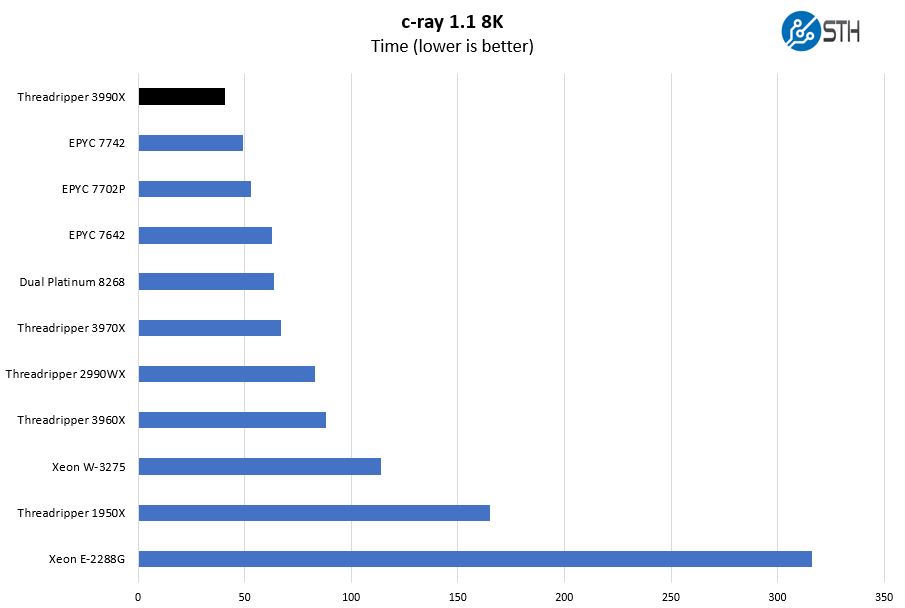
It is very hard to see in these charts, but we did get a fairly consistent but within test variation result set than we got using consumer motherboards. Generally, this was a 0.4-0.8% difference so it is less than a pixel difference in our charts and is what we consider within a standard test variance.
7-zip Compression Performance
7-zip is a widely used compression/ decompression program that works cross-platform. We started using the program during our early days with Windows testing. It is now part of Linux-Bench.
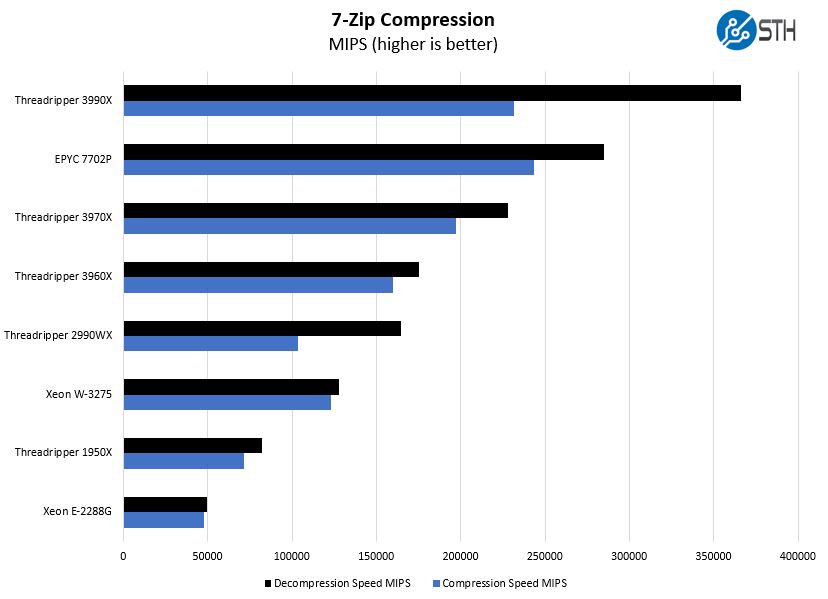
Compared to a lot of the single-socket Xeon solutions, this type of platform makes sense when using lower-capacity memory footprints. Threadripper offers more performance. The third generation of Ryzen Threadripper is, in our estimation, a better fit for a server platform than the AMD Ryzen Threadripper 2990WX was due to PCIe Gen4 support, a better architecture, and the possibility to scale well beyond what Xeon offers today.
OpenSSL Performance
OpenSSL is widely used to secure communications between servers. This is an important protocol in many server stacks. We first look at our sign tests:
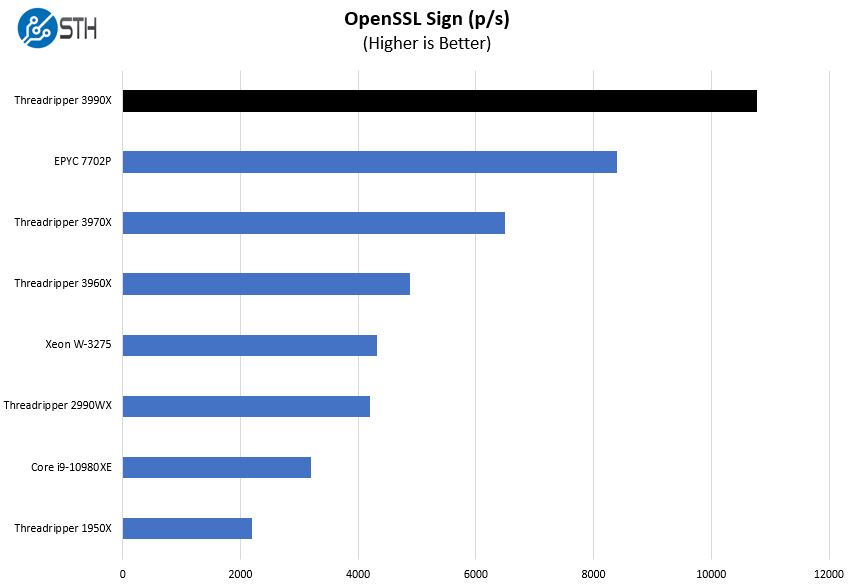
Here are the verify results:
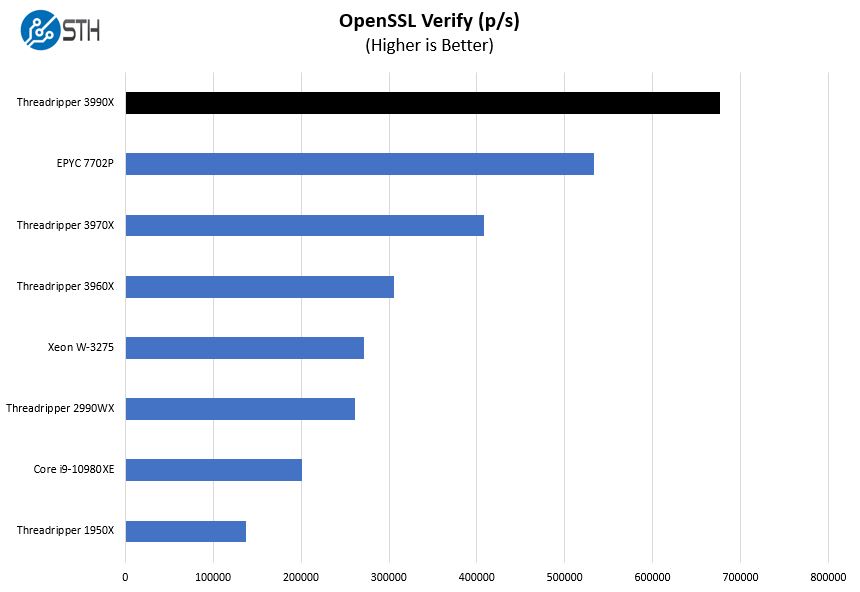
When we look at performance compared to the AMD EPYC 7702P it is fairly clear what a lot of additional TDP headroom can offer with AMD architectures. While the TRX40D8-2N2T is more of a solution for a specific market, there are many cases where the EPYC 7702P makes more sense even if the purely core-based performance is lower.
Chess Benchmarking
Chess is an interesting use case since it has almost unlimited complexity. Over the years, we have received a number of requests to bring back chess benchmarking. We have been profiling systems and are ready to start sharing results:
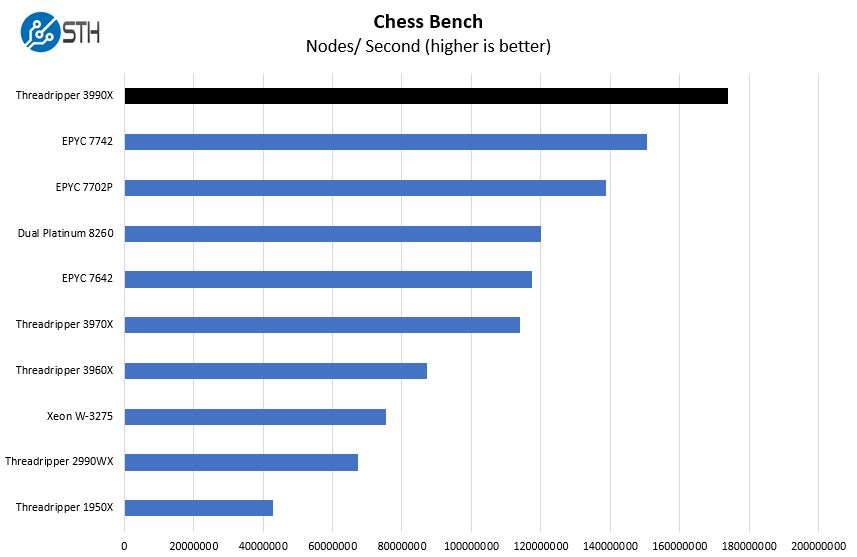
Like our c-ray test, our chess test scales very well with clock speeds and cores. As a result, we can see that the Threadripper 3990X performs extremely well here. While we have been focused on the 64-core parts, the Threadripper 3970X is considerably faster with 32 cores than the Intel Xeon W-3275 which is Intel’s top-end 28 core competitive offering. The TRX40D8-2N2T is designed to allow its buyers to exploit this performance advantage.
Next, we are going to get to our power consumption followed by market impact and our final words.




This motherboard would work also a workstation ? (with Windows sleeps and standby)
Good review.
“just” only 4 PCIe slots is a bit disappointing. Their previous model X399D8A-2T had 6 slots. NICs i255 + X710 is interesting.
Too bad AMD and Intel keep sticking to UDIMM.
It’s stupidly expensive memory, even on the second hand market.
Looks like a nice board though. Hope to one day consolidate my home servers to one box, but that will be RDIMMs for which CPU’s are very expensive.
weust, Intel is not sticking to UDIMM solely. Only their lowest Xeons are there (W-12xx). Once you get to W-22xx, you use (L)RDIMMs. The question is if you like to purchase slower CPU than competition and yet for way much more money. It’s basically RAM vs. cores/speed decision. Ignoring security bugs…
KarelG, security bugs is why I wouldn’t want Intel for now.
Sadly the Epyc CPU’s are too expensive for home use, afaik. I mean, I haven’t really looked but from what I’ve seen so far even the low core models are very expensive.
Right now my setup works, even though it mainly is Intel, so there is no need. Just a want.
With Threadripper Pro available Threadripper NON Pro needs to go back to its HEDT roost and stay there with its 4 memory channels and 64 PCIe 4.0 lanes. Threadripper Pro is the real workstation SKU and 8 memory channels and 128 PCIe 4.0 lanes and support for RDIMMs/Other ECC memory. Threadripper Pro is 2TB of memory support while Consumer Threadripper is only 256MB of memory capacity limited.
If one is using a lot of expensive ECC memory then having 8 memory channels and the possibility of 16 DIMM slots, at 2 DIMM slots per channel, presents a load more memory population options where one can purchase more of the lower cost/lower capacity ECC DIMMs and populate the MB with a larger amount of memory that way.
Used ECC Reg RAMs are way cheaper than ECC Unbuf RAMs and EPYC was sold at cheap price by HPE upgrade parts, so I choose EPYC over Threadripper for price.
https://forums.servethehome.com/index.php?threads/amd-epyc-rome-cpu-via-hpe-upgrade-very-cheap.26877/
“.. we also have a project coming using this motherboard and a passive cooler”; hopefully the project will use a cooler that will fit within a server chassis.
For 1/2 U chassis we will be trying the Dynatron L18 AIO CPU Cooler, it’s rated for the 3rd gen Threadrippers, so will be interesting to see how it handles our 3D rendering
Bought this board with a 3960X. System: four 32gb dimms, one ssd, five fans, no discrete video card.
Idle: 95W
Maximum observed power draw (prime95 blend): 311/314W, using two different power meters, one of which is a Fluke.
I dunno how you got 442W.. May you investigate a bit about that?
How many SATA drives will the BIOS correctly enumerate? Sadly, I have found that MB manufacturers fail to publish this parameter which is crucial in some server configurations. For example, 20 is a typical number, and that may be insufficient for a storage server.
I just bought this board and am having trouble enabling XMP. After enabling the system won’t POST and I have to clear CMOS to get it back. The XMP profile for this RAM is 3600mhz and 1.35v. Has anyone tried enabling XMP on this board? I reached out to Asrock just now. I’ll probably hear back from them tomorrow.